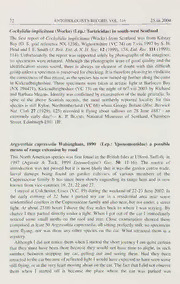
Cochylidia implicitana (Wocke) (Lep.: Tortricidae) in south-west Scotland PDF
Preview Cochylidia implicitana (Wocke) (Lep.: Tortricidae) in south-west Scotland
72 ENTOMOLOGIST’S RECORD, VOL. 116 25.iii.2004 Cochylidia implicitana (Wocke) (Lep.: Tortricidae) in south-west Scotland The first report of Cochylidia implicitana (Wocke) from Scotland was from Kilstay Bay (O. S. grid reference NX 1238), Wigtownshire (VC 74) on 7.viii. 1997 by S. H. Hind and I. F. Smith (J. Brit. Ent. & N. H. Soc. 12 (1999), 158; Ent. Rec. Ill (1999), 1 14). Unfortunately, the report was supported solely by photographs of the imagines; no specimens were retained. Although the photographs were of good quality and the identification seems sound, there is always an element of doubt with this difficult group unless a specimen is preserved for checking. It is therefore pleasing to vindicate the correctness of that record, as the species has now turned up further along the coast in Kirkcudbrightshire. Three specimens were taken at actinic light at Barlocco Bay (NX 794471), Kirkcudbrightshire (VC 73) on the night of 6/7.viii.2003 by Richard and Barbara Mearns. Identity was confirmed by examination of the male genitalia. In spite of the above Scottish records, the most northerly reported locality for this species is still Kyloe, Northumberland (VC 68) where George Bolam (Hist. Berwick Nat. Club 27 (1929),—125) recorded it flying about sallows on 28 June 1887 - an extremely early date! K. R Bland, National Museums of Scotland, Chambers Street, Edinburgh EH1 1JF. Argyresthia cupressella Walsingham, 1890 (Lep.: Yponomeutidae) a possible means of range extension by road This North American species was first found in the British Isles at Ufford, Suffolk in & 1997 (Agassiz Tuck, 1999 Entomologist’s Gaz 50: 11-16). The source of . introduction was not proved but it is most likely that it was the garden centre trade, larval damage being found on garden cultivars of various members of the Cupressaceae family. It has since been slowly expanding its range here and is now known from vice-counties 19, 21, 22 and 27. I stayed at Colchester, Essex (V.C. 19) during the weekend of 22-23 June 2002. In the early evening of 22 June I parked my car in a residential area near some unidentified conifers in the Cupressaceae family and also near, but not under, a street light. At about 23.00 hours I drove the five miles back to where I was staying. By chance I then parked directly under a light. When I got out of the car I immediately noticed some small moths on the roof and rear. Close examination showed these comprised at least 50 Argyresthia cupressella all sitting perfectly still; no specimens , were flying, nor was there any other species on the car. What attracted them is a mystery. Although I did not notice them when I started the short journey I am quite certain that they must have been there because they would not have time to alight, in such number, between stopping my car, getting out and seeing them. Had they been attracted to the car because ofreflected light I would have expected to have seen some still flying, or at the very least moving about on the car. The fact that I did not observe them when I started off is because the place where the car was parked was
